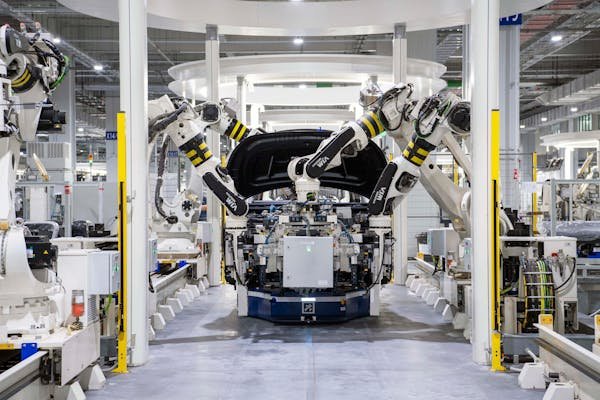Advanced Robotics Solutions for Automation: Transforming Industries with Innovation
The landscape of manufacturing, logistics, healthcare, and countless other industries is undergoing a seismic shift. As technology continues to evolve, one of the most significant drivers of change is the rise of advanced robotics solutions for automation. These cutting-edge robotic systems are transforming business operations by enhancing efficiency, precision, safety, and scalability, creating new possibilities in various sectors.
In this article, we will explore the latest advancements in robotics solutions for automation and how these innovations are redefining industries around the globe.
The Rise of Advanced Robotics in Automation
Robotics has long been a part of industrial automation, but recent advancements in artificial intelligence (AI), machine learning, and sensor technologies have propelled these systems into new heights of performance. Today’s robots are not just programmed to follow simple tasks; they are capable of making autonomous decisions, learning from their environment, and even interacting with humans in more intuitive ways.
These new robotic solutions come in many forms, including collaborative robots (cobots), autonomous mobile robots (AMRs), and more specialized robotic arms, which are revolutionizing industries such as manufacturing, logistics, healthcare, and even agriculture.
Key Technologies Driving Robotics for Automation
Several key technologies are pushing the envelope in robotics solutions for automation. Here are some of the most important:
- Artificial Intelligence (AI) and Machine Learning
AI enables robots to perform tasks autonomously without human intervention. Through machine learning, robots can analyze data, learn from past experiences, and continuously improve their performance. For example, AI-driven robots can identify anomalies in production processes, predict maintenance needs, or optimize their own movements based on real-time feedback. - Robotic Vision Systems
Advanced vision systems allow robots to “see” their environment in high definition. With the help of cameras, lidar, and infrared sensors, robots can perform complex tasks such as quality inspection, object recognition, and even picking and sorting in dynamic environments. Robotic vision systems are critical for operations like assembly, where precision and attention to detail are paramount. - Collaborative Robotics (Cobots)
Cobots are robots designed to work alongside human operators, enhancing productivity without replacing jobs. Cobots are equipped with safety features, such as force sensors, that enable them to interact safely with humans. These robots are ideal for industries where human expertise is essential but routine tasks can be automated for efficiency, such as assembly lines or packaging. - Autonomous Mobile Robots (AMRs)
AMRs are robots that can move around a facility or warehouse without human intervention. Equipped with advanced navigation systems, AMRs can transport materials, stock inventory, or deliver goods. These robots are increasingly used in warehouses, retail environments, and logistics hubs to streamline operations and reduce costs. - Edge Computing and IoT Integration
Edge computing allows robots to process data locally instead of relying on centralized cloud systems. This reduces latency, improves decision-making speed, and makes robotics solutions more adaptable in real-time operations. When integrated with the Internet of Things (IoT), robots can communicate with other machines, devices, and systems, creating a smart ecosystem where all components are interconnected for optimal performance.
Applications of Advanced Robotics Solutions
The versatility of robotics solutions for automation is evident across a wide range of industries. Let’s examine some notable applications:
1. Manufacturing
The manufacturing sector has long been a pioneer in robotic automation, and today, robots are used to carry out tasks that were once time-consuming or dangerous. Advanced robotics can automate assembly, welding, painting, material handling, and more. Robotics enables manufacturers to increase production rates, improve quality control, and reduce human error, while minimizing the risk of injury.
Moreover, robots can perform tasks with high precision, often operating in environments with little to no human supervision. This is particularly useful in automotive, electronics, and heavy industry sectors where high throughput and meticulous attention to detail are essential.
2. Logistics and Warehousing
In logistics and warehousing, robots are integral in automating order fulfillment and supply chain operations. Autonomous mobile robots (AMRs) are used to transport inventory across large warehouses, optimizing picking, sorting, and packaging processes. Coupled with AI, these robots can predict demand, reroute traffic in busy environments, and dynamically adjust to workflow changes.
The integration of robots with IoT systems also allows for real-time monitoring of inventory, reducing the risk of errors, and improving stock management. As e-commerce continues to grow, the importance of robotic automation in logistics cannot be overstated.
3. Healthcare and Medicine
In healthcare, robotics has the potential to revolutionize surgeries, patient care, and administrative tasks. Surgical robots, such as the da Vinci Surgical System, allow for highly precise, minimally invasive procedures that enhance recovery times and reduce patient risk. Similarly, robotic exoskeletons and assistive devices are transforming rehabilitation for individuals with mobility impairments.
In the pharmaceutical industry, robots are used for research, drug development, and packaging, ensuring accuracy and efficiency in these highly regulated environments. Automation also plays a role in managing hospital logistics, delivering medications, and assisting in sanitation efforts.
4. Agriculture
Agriculture is increasingly benefiting from robotics solutions designed to increase crop yields and reduce labor costs. Autonomous robots can monitor crops, apply fertilizers, and even harvest fruits and vegetables. These robots use advanced sensors to detect plant health, pests, and soil conditions, allowing farmers to optimize their practices and reduce environmental impact.
Additionally, the rise of drone technology allows farmers to monitor large fields more efficiently, mapping out areas that need attention or intervention. By automating routine agricultural tasks, robots are improving sustainability and reducing the strain on human workers.
Challenges and Considerations
While the advantages of advanced robotics for automation are clear, there are several challenges that need to be addressed. One of the biggest concerns is the potential impact on the workforce. Although robots can handle repetitive tasks, concerns remain regarding job displacement. However, many experts argue that automation will create new jobs, particularly in robot maintenance, programming, and management, offering opportunities for reskilling.
Another challenge is the high upfront cost of implementing robotic systems. Small and medium-sized businesses may face barriers to adopting these technologies due to the initial investment required. However, the long-term benefits, including increased productivity and cost savings, often outweigh these concerns.
The Future of Robotics in Automation
As technology continues to advance, the future of robotics in automation looks even more promising. With further developments in AI, machine learning, and cloud computing, robots will become even more intelligent and adaptable. We can expect to see more advanced robots that can handle increasingly complex tasks, work more seamlessly with humans, and operate across a wider range of industries.
Additionally, as robots become more affordable and accessible, small and medium-sized enterprises (SMEs) will likely adopt automation solutions, further transforming industries. With ongoing investment in research and development, robotics will continue to be a critical element in shaping the future of automation.
Advanced robotics solutions are already having a profound impact on automation, reshaping industries and improving productivity, precision, and safety across various sectors. As AI, machine learning, and sensor technologies continue to evolve, robots will be able to perform an even wider range of tasks with increasing autonomy. While there are challenges ahead, the future of robotics in automation promises a world where industries can achieve new levels of efficiency and innovation. The key lies in harnessing these technological advancements responsibly and ethically to maximize their potential benefits.
FAQs on Advanced Robotics Solutions for Automation
- What are advanced robotics solutions for automation? Advanced robotics solutions for automation refer to the use of cutting-edge robotic systems that leverage technologies such as artificial intelligence (AI), machine learning, sensor systems, and advanced software to perform tasks autonomously or in collaboration with humans. These solutions are implemented in various industries, including manufacturing, healthcare, logistics, and agriculture, to improve efficiency, accuracy, and safety in operations.
- How do robots enhance efficiency in industries? Robots improve efficiency by automating repetitive, time-consuming, or dangerous tasks, which allows human workers to focus on more complex or creative activities. They can work 24/7 without the need for breaks, leading to higher production rates, reduced downtime, and consistent output. Advanced robots can also learn from their environments and adapt to changes in real-time, further optimizing workflows.
- Are collaborative robots (cobots) safe to work alongside humans? Yes, collaborative robots (cobots) are specifically designed to work alongside human operators in shared environments. They are equipped with safety features such as force sensors and advanced vision systems that help detect and prevent collisions. Cobots can pause or adjust their movements if they sense the presence of a human, ensuring a safe and efficient collaboration between robots and people.
- What industries benefit most from robotic automation? Several industries benefit from robotic automation, including:
- Manufacturing: Robots are used in assembly lines, welding, and material handling.
- Logistics and Warehousing: Robots streamline tasks like inventory management, picking, and sorting.
- Healthcare: Robotics improve surgical precision, assist with rehabilitation, and handle logistics in hospitals.
- Agriculture: Robots automate planting, harvesting, and monitoring crop health.
- What challenges are associated with implementing advanced robotics solutions? Some challenges include the high initial investment required for robotic systems, which may be a barrier for small businesses. Additionally, the implementation of automation can raise concerns about job displacement, though many experts argue that robotics can create new roles in robot maintenance, programming, and management. Another challenge is the need for ongoing training and integration of robotic systems into existing workflows. Despite these challenges, the long-term benefits often outweigh the costs.













Post Comment